#curio rowleyanus
Text
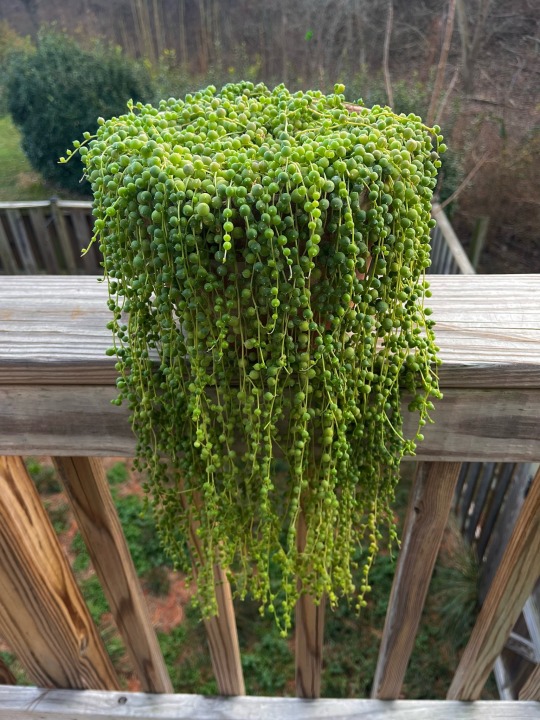
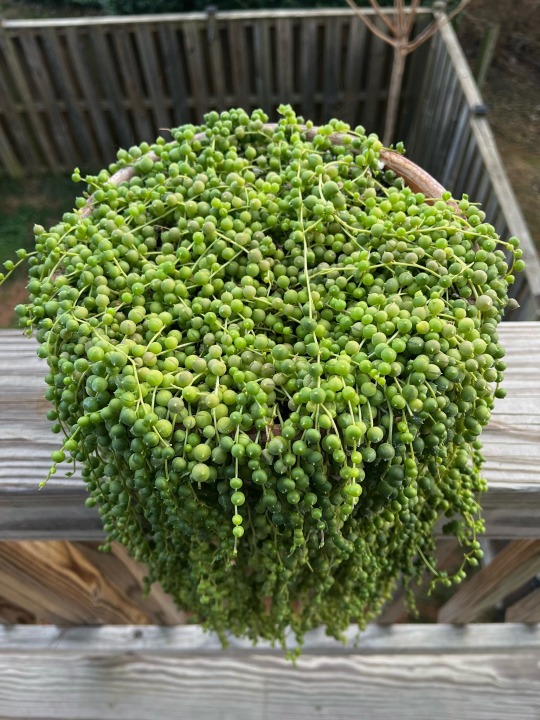
Curio rowleyanus / String of Pearls
#it'd be much longer if i hadnt trimmed it a bunch since i bought it#i always trim it once it starts touching the floor :p#also the white residue on some of the pearls is just diatomaceous earth from when i was battling thrips earlier this yr#string of pearls#curio rowleyanus#senecio rowleyanus#succulent#succulents#succulentblr#plant#plants#plantblr#plantas#trailing plants#horticulture#botany#houseplants#mine#curio#senecio
126 notes
·
View notes
Text
Went out shopping with mum and bought myself a pot of Variegated String of Pearls (Curio rowleyanus) or better known by its synonym Senecio rowleyanus. This creeping succulent vine is native to the Cape Provinces of South Africa. Also called string of beads, it comes in both green and variegated colours. The latter had pearl-like leaves that are swirled in cream, green and sometimes even pink and purple colours with the right combination of sun stress and water.


youtube
Green String of Pearls image from here.
#String of Pearls#Curio rowleyanus#String of Beads#Senecio rowleyanus#Green Form#Variegated Form#Vine#Cape Provinces#South Africa#Succulent#Flora#Plant#Plant Care Video#Youtube#Non-Food#Buffetlicious
27 notes
·
View notes
Text
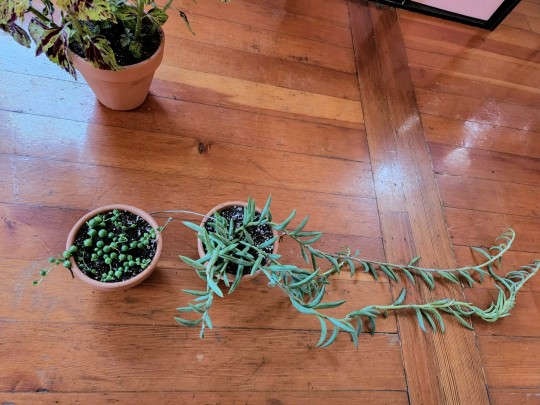

Got a bonus plant the other day, ended up with both for only 6 dollars 😊
Curio radicans (string of bananas), and Curio rowleyanus (string of pearls)
21 notes
·
View notes
Text
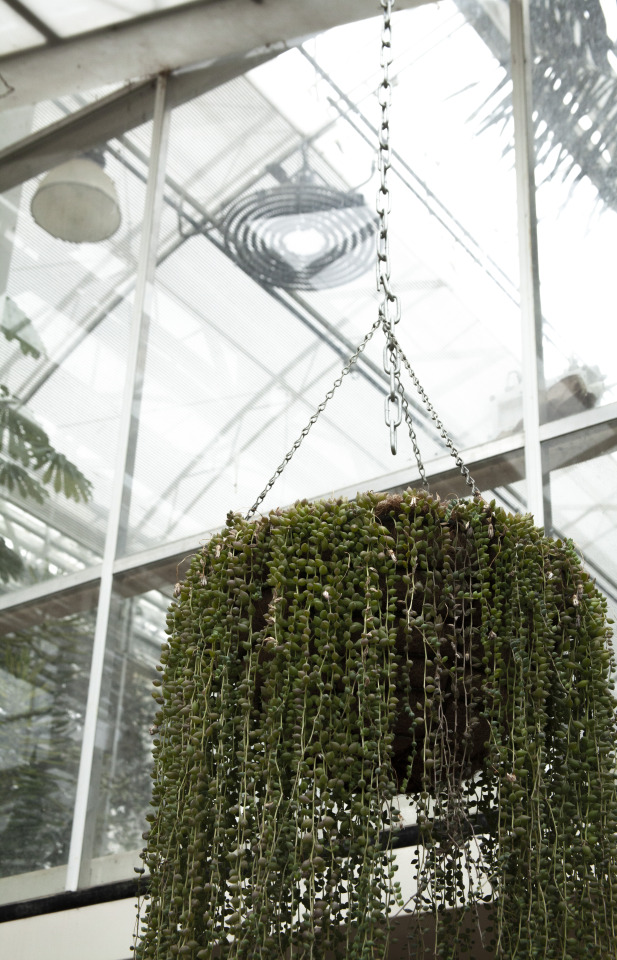
Curio rowleyanus~ String Of Pearls
#photography#my photgraphy#photograhers on tumblr#photooftheday#photographer#my photos#art#cannon camera#nature#photographers on tumblr#string of pearls#plants
5 notes
·
View notes
Text
🌱Complete Guide: How to Grow String of Pearls 🌱
🌱
0 notes
Text
How to Care for String of Pearls Plants
The String of Pearls, also known as the Curio Rowleyanus, is a unique trailing succulent. If I were to name one plant that has my heart, it would be this one. I think it is the most beautiful houseplant!
The plant originates from the southern tip of Africa, and its uniqueness makes this plant a favorite for plant parents. String of Pearls is a creeping succulent that has green balls for leaves…

View On WordPress
0 notes
Text

Курио Роули или син. Крестовник Роули (лат. Curio rowleyanus, син. Senecio rowleyanus) — вид суккулентных растений из рода Курио, семейства Астровые.
Это стелющаяся многолетняя сочная лиана, произрастающая в более засушливых частях юго-западной Африки. В естественной среде его стебли стелются по земле, укореняясь там, где соприкасаются, и образуют плотные коврики. Он часто избегает прямых солнечных лучей, растёт в тени других растений и камней. Он широко известен как нить жемчуга или нить бус (string-of-pearls or string-of-beads)
Необычная форма листьев является адаптацией к засушливой среде и позволяет хранить воду, при этом минимальная площадь поверхности на единицу объема подвергается воздействию сухого пустынного воздуха. Хотя его сферическая морфология листа способствует минимизации потери воды, он также значительно уменьшает площадь поверхности, доступную для поглощения света и фотосинтеза.
Адаптация, которая может помочь компенсировать это уменьшение перехвата света, представляет собой узкую полупрозрачную полосу ткани в форме полумесяца на адаксиальной стороне пластинки. Эта специализированная структура известна как « эпидермальное окно », и она позволяет свету проникать внутрь листа и облучать его, эффективно увеличивая площадь ткани листа, доступную для фотосинтеза.
25 Rimutaka Place, Titirangi, Auckland 0604
0 notes
Text
Colar de golfinhos – Senecio peregrinus

Nome Científico: Senecio peregrinus
Sinónimos: Curio peregrinus, Curio x peregrinus, Senecio x peregrinus, Dendrophorbium peregrinus
Nomes Populares: Colar de golfinhos, Planta-golfinho, Golfinhos-voadores, Cordão-de-golfinhos
Família: Asteraceae
Categoria: Cactos e Suculentas, Folhagens
Clima: Subtropical, Tropical
Origem: África, África do Sul
Altura: 0.1 a 0.3 metros
Luminosidade: Luz Difusa, Meia Sombra
Ciclo de Vida: Perene
Cada folha suculenta desta planta incrível é uma réplica perfeita de um golfinho.
Dispostas ao longo de caules finos e compridos, em intervalos regulares, estas estruturas assemelham-se a um alegre grupo de golfinhos a saltar sobre as águas.
A Senecio Peregrinus vem de uma polinização cruzada entre a Senecio Rowleyanus (Colar de Pérolas) e Senecio Articulatus, e pode atingir até 15 centímetros de altura.
Em altura o colar de golfinhos não ultrapassa 15 centímetros, mas se for cultivado como planta pendente, os seus ramos podem ultrapassar um metro de comprimento facilmente.
A sua folhagem é muito característica, de cor verde-clara a levemente acinzentada e apresenta-se no formato de golfinhos, suculentos, que actuam como janelas que permitem o máximo de entrada de luz e reduzem o excesso de transpiração ao mesmo tempo, como muitas espécies de suculentas que tem folhas parcialmente transparentes.
https://youtu.be/AeNRLieI7x0
Como cultivar Colar de golfinhos
Deve ser cultivado sob meia sombra ou abundante luz filtrada, solo perfeitamente drenável e regas espaçadas.
As condições ideais de luminosidade para a espécie incluem abundante iluminação indirecta o dia todo, com algumas horas de sol directo pela manhã.
O sol quente do meio dia e da tarde provocam queimaduras nas folhas.
Da mesma forma que outras suculentas, o colar-de-golfinhos aprecia que o seu substrato seque entre as regas, mas ele pode conter um pouco mais de matéria orgânica que o comum para suculentas, uma vez que aprecia um pouco mais de humidade.
Mas cuidado, o colar-de-golfinhos é igualmente sensível a encharcamentos e consequente redução na aeração do substrato, que provoca o apodrecimento das raízes e morte da planta.
Durante o inverno, é importante reduzir as regas, mantendo o substrato ligeiramente mais seco.
Não tolera geadas ou frio intenso, e deve ser levado para ambientes internos durante invernos rigorosos.

As flores do Colar de golfinhos
Apesar de ser raro que o colar de golfinhos floresça, caso seja cultivado dentro de casas e apartamentos, as suas flores são bastante parecidas com aquelas produzidas pelo colar de pérolas, um dos seus progenitores.
Além da coloração branca e da anatomia composta, as flores desta planta exalam um aroma muito parecido com o da canela.
Ainda assim, a suculenta colar de golfinhos é uma excelente opção de planta para ser cultivada em interiores.
Qualquer ambiente no qual o colar de pérolas se desenvolva bem será propício para o colar-de-golfinhos, uma vez que descende dele.
Multiplica-se facilmente por estaquia de segmentos do caule, postos a enraizar no substrato ou em água, ou por mergulhia, prendendo ramos com grampos sobre o substrato para que criem novas raízes em contacto com a terra.
Após o enraizamento dos segmentos, o que pode levar de duas a três semanas, podemos separar as mudas da planta mãe e plantar em local definitivo.
Vaso de plástico ou de barro?
O vaso para o cultivo da suculenta colar-de-golfinhos pode ser de barro ou de plástico.
Contudo, como esta é uma planta que se torna pendente, com o tempo, o mais seguro é optar pelo plástico, que é mais leve e pode ser suspenso com maior facilidade.
Read the full article
0 notes
Text
Blue String of Pearl Plants: Do They Even Exist?
Blue String of Pearl Plants: Do They Even Exist?
The string of pearls is a distinct plant with spherical leaves that originates from South Africa. It’s a succulent in the genus Curio, but scientists identify it as Senecio rowleyanus in the field.
The plant grows from a weak surface root network. The trailing stems can grow up to three feet long before the plant touches the soil and begins another root network. Because the plant prefers not to…

View On WordPress
0 notes
Photo

I know a lot of people struggle with this trailing succulent, so I figured a care guide was in order! ⬇
How to care for a string of pearls succulent
Get the free PDF on 10 easy houseplants
14 notes
·
View notes
Text

This arrangement has come a long way since Christmas. Some things have died and been pulled out, others have been added. The String-of-Pearls, Echeveria 'Lola', Schlumbergera, and Crassula mesembryanthemoides are all original residents, though the Crassula did rot originally and needed to be cut and rerooted. But it's doing fine now! There were Sedum rubrotinctum in there but they also sadly rotted, though there's a tiny pup from a leaf nestled next to the Lola that's doing okay. The Sedum adolphi also rotted and was pulled out, there's still a hole in the back next to the Schlumbergera that I haven't filled in.
The other Echeveria 'Ramillete' and it's crested form are new so we shall see how they fair.
I tend to water this when the Schlumbergera calls for it which has worked for the other plants so far! The ones that rotted was probably due to a combination of repotting with the soil moist and past treatment at the store we bought them from (Home Depot, and it had rained on them).
#succulents#plants#plantblr#Schlumbergera#echeveria lola#echeveria ramillete#crassula mesembryanthemoides#string of pearls#curio rowleyanus#Senecio rowleyanus#arrangements#succulent arrangements#succygirl's photos#succygirl's succulents
78 notes
·
View notes
Text


Hanging plants means unlimited power, yes?
Two Hoyas and one string-of-pearls.
19 notes
·
View notes
Text

Newest addition - variegated Curio rowleyanus
31 notes
·
View notes
Text



Here are my first three plants in LECA/ semi-hydro
Pictured here is: Philodendron “Brazil”, Golden pothos, and string of pearls
#Philodendron hederaceum#Epipremnum aureum#Curio rowleyanus#LECA#Semi hydroponics#passive hydroponics#house plants#cottagecore#grandmacore
10 notes
·
View notes
Photo

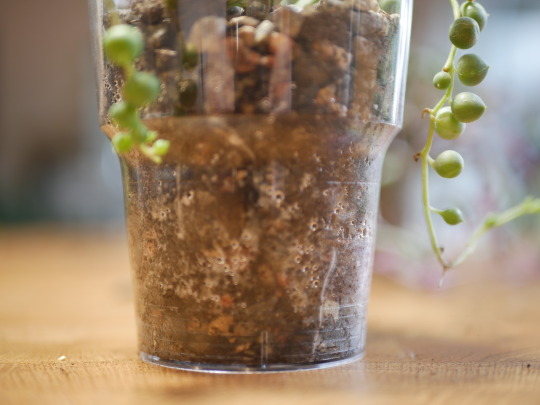
I got my curio/senecio herreianus “Purple Flush” and curio/senecio rowleyanus on September 1, they arrived bare rooted and it was not fun trying to get them untangled and into a pot, which I didn’t have because I assumed they would arrive in a pot so I bought some plastic cups and made holes in them because I couldn’t find any pots.
But it did give me a window into the pot and herrianus send out roots so fast. A cutting rooted in one day, ONE DAY! Herrianus pot is full of roots while I can only see two roots in rowleyanus pot.
With all the roots herrianus drinks a lot more water and I got curious to try him in water culture along with my peperomia prostrata.
#curio herreianus#senecio rowleyanus#curio rowleyanus#in my collection#lovely pots!#senecio herreianus#succulents
0 notes
Text

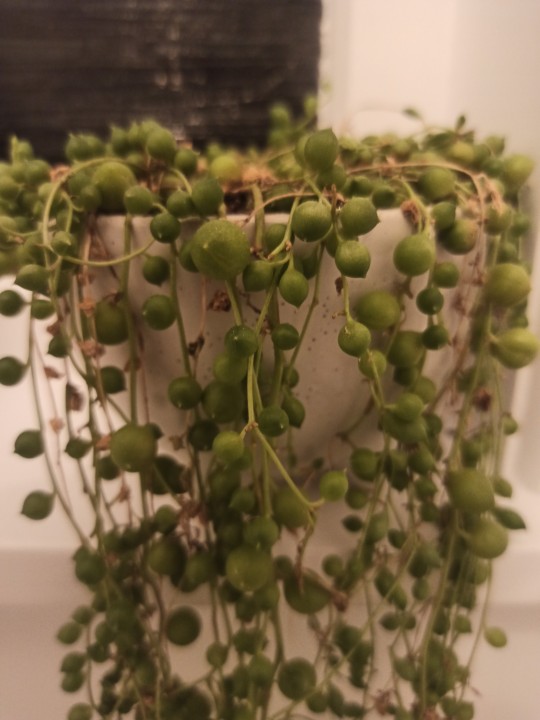
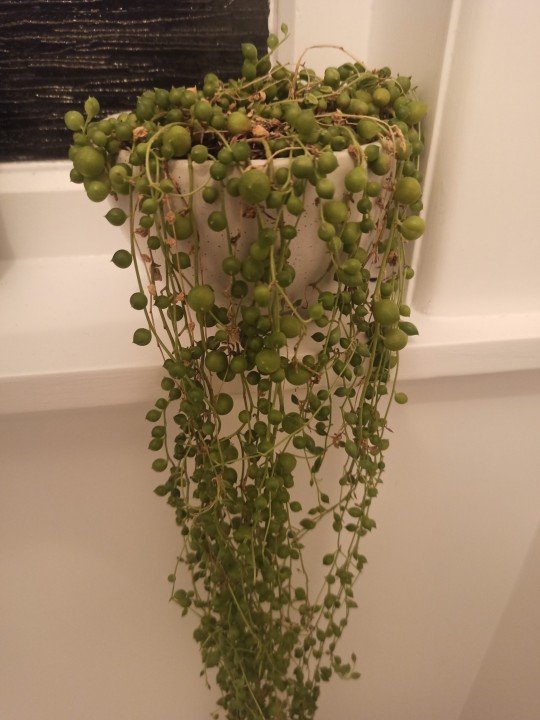

Curio rowleyanus, syn. Senecio rowleyanus, is a flowering plant in the daisy family Asteraceae. It is a creeping, perennial, succulent vine native to the drier parts of southwest Africa. In its natural environment its stems trail on the ground, rooting where they touch and forming dense mats. It often avoids direct sunlight by growing in the shade of other plants and rocks. It is commonly known as string-of-pearls or string-of-beads.
23 Rimutaka Place, Titirangi, Auckland 0604
-36.9441360, 174.6356360
0 notes